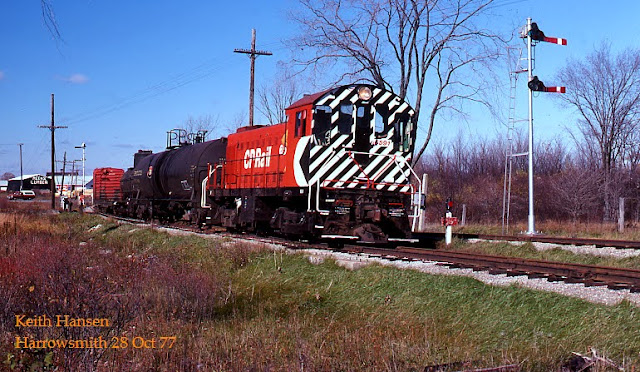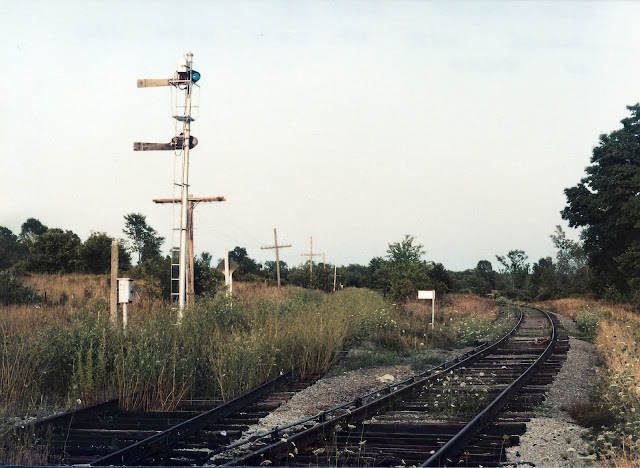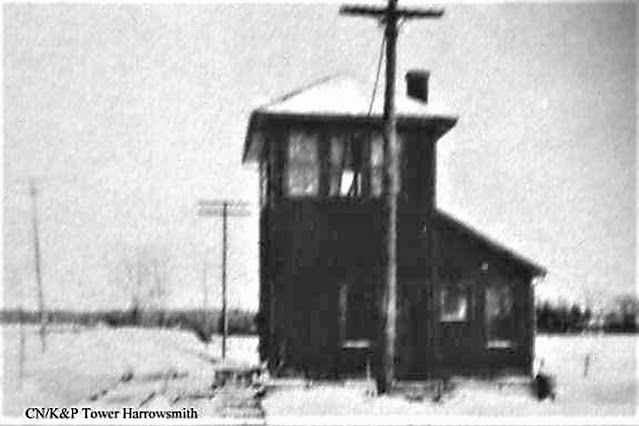CN freights and CP wayfreights still passed through Harrowsmith in the 1970's. On the morning of October 28, 1977 CP 6591 has traversed CP's Belleville Subdivision from Smiths Falls to Tichborne, now heading south on the Kingston Subdivision to Kingston with two tank cars, a flat car and a boxcar visible. By this time, CP had lost access to its customers in downtown Kingston that were increasingly switched by CN, though still making use of their interchange with CN.
An earlier down-and-back trip on April 25, 1969 a few years after the steam era ended, included a CP gon, two CP covered gons, a coal car and combination CP script 50-foot boxcar pulled by 8045 and a script end-cupola van 436741, returning with a CP gon, ice reefer, CP gon with a container, and two tank cars.
A 1971 CN track schematic depicted the joint section at Harrowsmith Mi. 85.0:
"CPR Main Track Switches owned and maintained by CNR. Siding 1165 feet and shorter siding 480 feet, owned and maintained by CPR"
Passenger train times at Smiths Falls (shown as 24-hour clock):
CN 1966 "Capital" Daily Ex.Saturday, reportedly operating with GMD-1's!
- 0015 No 213 arriving Toronto 0615
- 0505 No 214 arriving Ottawa 0640
Oct. 1977 VIA system timetable (the year before the overnight service changed to Montreal-Toronto, with two-car Ottawa section operating Brockville-Ottawa):
- 0100 No 49 Ottawa-Napanee-Toronto
- 0730 No 48 Toronto-Napanee-Ottawa
As a prolific photographer, the late Keith Hansen stopped in Harrowsmith a few times among his wide-ranging and well-photographed travels. He kindly shared with me, and now you, five of the photos he took there. On July 19, 1977 a westbound CN freight behind 3207 and a Geep heads through Harrowsmith on its way from Smiths Falls to Napanee, here crossing Highway 38 near Meeks Lumber. CP's main track, siding and back track are in the foreground:
Three months later, CN 3239 heads a single-unit eastbound splitting the semaphores on the joint section, carrying on the CN for Sydenham and points east. The white-painted station is visible at far left:
This photo (below) is from an online auction photo site, but is likely a version of Keith's photo of the tail-end of the same train as above. A curious crew member looks back at the photographer from Hawker-Siddeley caboose 79219, with the CP track parallel but soon to veer southward visible at right. Passing through a curving rock-cut toward Murvale, the CP track was sometimes covered in caterpillars early in the year, then leaves later in the year. Because of this seasonal phenomenon, my father-in-law mentioned that the CP often had to back up and take another run at it!
The same day, Keith caught the northbound CP train returning behind S-3 6591, seen southbound in the top photo. The head-end trainman is on the front steps to throw the joint section switch, with at least five CP boxcars on the pin:
Tail-end trainman on the van steps to re-line switches for CN use. Meeks Lumber shed is visible in distance at left, and notice the interesting load in that CP gondola:
As early as 1976, I was interested in catching CP on their sporadic schedule serving Kingston. As the Superintendent noted in this letter, there was no schedule!
Topographic map of Harrowsmith. The road to Sydenham has been straightened, and the CP station is no longer shown north of the tracks, having been moved across the tracks to Meeks Lumber. Based on photos taken 1976; map date 1979.
In April 1974, the Bytown Railway Society's Bruch Chapman planned an Ottawa-Kingston and return, excursion with CP RDC-1 9072 including several run-bys. Photo courtesy Jakob Mueller. Enthusiasts are trackside for a photo run-by:
And this photo via Bruce Chapman/Colin Churcher, with semaphore on CN in the Proceed position. Look at that clean CP ballast! The fantrippers are re-boarding as the white-flagged Dayliner prepares to head south for another photo stop at Murvale at its former station dwelling.
In October, 1974 the Bytown Railway Society operated a well-photographed Ottawa-Napanee excursion with GM-MLW cab units. Note interlocking rods and joint section.
Bob Meldrum kindly shared this nice colour photo of the fantrip:
My Dad sometimes crossed the tracks at Harrowsmith on his way to Sydenham High School, where he taught English for 15 years. On a summer trip, maybe driving up to prepare for the upcoming school year, he snapped an eastward view at Highway 38. L.C. Gagnon photo, August 1975:
On July 16, 1984, Sperry Rail Service car 129 attempted to test the rails on CP Kingston Sub. Testing was abandoned due to rust on rails. The semaphores were dismantled and taken to the Smiths Falls Railway Museum in May, 1986 by members of the museum, Bytown Railway Society and a local electrical contractor with a boom truck.
A similar angle (above) begins a series of photos taken by CN S&C Signal Maintainer Gene Burles, undated. This view shows the switches lined for the weed-grown CN:
West of Highway 38:
East of Highway 38 looking west:
Looking east with weed-grown CN:
The last revenue movement on the CP Kingston Sub was a military train northward from Kingston - 1 Canadian Signals Regiment heading to RV 85 (below - photo by Wilf Coombe, just east of Division St.) and its eventual return. This was in turn followed by the train of empties heading northbound. Following the abandonment of the CP line into Kingston, the 1CSR move from Kingston to the next biennial Canadian Forces joint exercise, RV87 was handled by CN.
The entire Canadian field army went west from across Canada for those exercises. The Canadian Forces traffic technicians were used to moving Canadian Forces armoured vehicles around Germany for years before! Paul Hunter kindly shared this screenshotted photo of CP 1816-875x leading the northbound movement of empties at Harrowsmith on June 25, 1985 (below). By 1986, the right-of-way was purchased by Bell Canada for fibre-optic communications.
During an April 20, 1986 visit to my future in-laws, whose house was just west of the CN steel girder bridge over the Harrowsmith-Sydenham line, I noted some track details. The bridge was built by Dominion Bridge, Montreal in 1965. Tie plates were dated 1928 and 1929, bracketed by old-style rail anchors. Rail was 85-100 lb/yard, dating as far back as 1921, some stamped Algoma Steel. A 6x12-foot washout punctured the roadbed, later to become the Cataraqui Trail just west of the bridge along Wilson Road. (South Frontenac municipal photo):
Harrowsmith station was moved off its foundations and across the tracks by 1969 and painted grey, owned by Meeks Lumber and used for storage, shown here in 2000:
This is the longest multi-part post in Trackside Treasure's short history. Even the Sceneramic sceries was only four parts, 'tiny lettering' mystery solved and all. Thanks for being along for the ride! We usually hopscotch around between posts but this series is being presented in chronological order for easier future scrolling, with all posts linked. In the fourth post, we follow the line east from Harrowsmith across that bridge, extended to Sydenham.
Running extra...
Recommended reading: Between Two Kingdoms by Suleika Jaouad. The book and its author were profiled recently on CBS Sunday Morning. Diagnosis, treatment, journey. Music by Jon Batiste.
James Hilton's two-track shelf layout portraying PEI is visually appealing in the less-is-more category.Here's a World War I postcard addressed to Violet Sigsworth in Harrowsmith, 1916:

















































